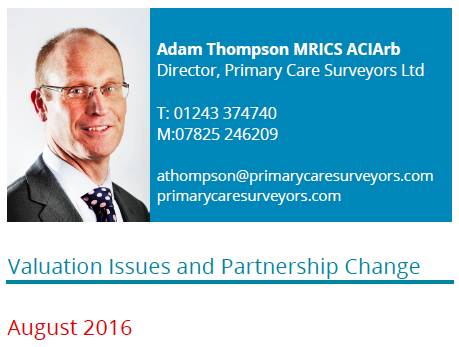
With many GP premises being owned within the partnership, there is frequent need for a valuation to be undertaken of the surgery premises, usually required when a partner is leaving or joining the practice.
The first consideration is the Partnership Agreement, if one exists. The agreement should include details of how the property is to be treated, but should also provide directions to the valuer as to the basis of valuation. This can be either to assume the property is to remain in use as a doctors’ surgery (existing use value) or to consider what else the property may be used for (alternative use value).
If the property is to continue in its existing use, the valuation will have regard to the prevailing Notional Rent as received by the practice, together with the valuer’s opinion as to whether that Notional Rent is likely to increase or decrease in the future. This is based upon the date the Notional Rent is due to be reviewed every three years. There may also be practices which are on Cost Rent, in which case this may form the basis of value depending on how long the Cost Rent is likely to continue for. Cost Rent is meant to cease automatically when the last mortgage has been redeemed or when Notional Rent exceeds Cost Rent (this will be covered in future articles).
If the basis of valuation is to include alternative use, then the valuer needs to consider the suitability of the premises for the ongoing provision of healthcare, since it may be that the correct course remains for the property to be valued as a surgery. This would be dependent upon whether the premises are modern and purpose-built, or of the dated house conversion type surgery nearing the end of its operational life.
With some conversion surgeries having been upgraded to a reasonable quality and with extensions being provided, these can sometimes be of as good specification as a dated purpose-built surgery. It may be that the premises are deemed to have an operational life for, say, 10 years, in which case it may be prudent to start providing valuations on both bases (namely existing use and alternative use). The risk of not doing so is that if we were to continue to value a dated surgery on the basis of its extant Notional Rent when it is evident that the property is not going to continue in healthcare for a significant number of years, then the capital value may be artificially stated on its existing use which may bear little relation to the true value in the market. This is not to say that the valuation is incorrect since it will have been undertaken in accordance with the Partnership Agreement, but it may be significantly higher than what the property may be worth in reality, particularly where the property may be suitable for redevelopment.
As ever, I will be glad to discuss issues arising further.

